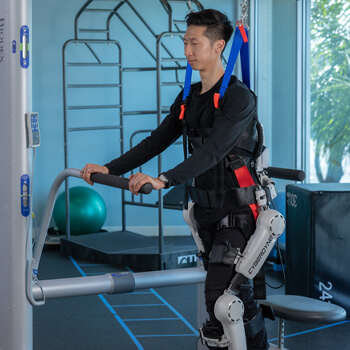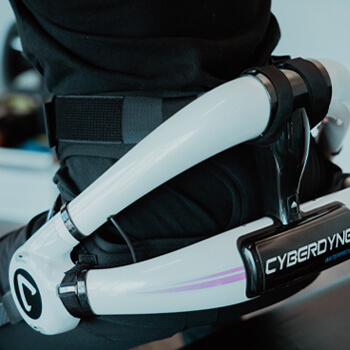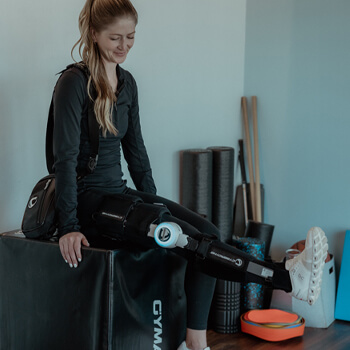
Meet HAL (Hybrid Assistive Limb)
Since 2021, RHG clinics have treated patients using our Hybrid Assistive Limb technology across a full spectrum of illnesses and injuries including:
- Spinal Cord Injury (SCI)
Stroke (CVA)
Traumatic Brain Injury (TBI)
Progressive Neuromuscular Disorder (PND)
Parkinson’s Disease
Cerebral Palsy, ALS and Multiple Sclerosis (MS) among many others.
HAL (Hybrid Assistive Limb) is a non-invasive, wearable technology that can sense the wearer’s intentions for movement through small sensors on the skin. It is the ONLY FDA cleared exoskeleton in the U.S. that actually improves mobility and ambulation.
Parkinson's HAL Patient
“RISE Healthcare Group has helped me like no other. Every time I go in for HAL treatment, I feel better walking out. I’ve enjoyed gaining back my independence and being able walk out in the yard or play with my grandkids.”
A Session with HAL (Hybrid Assistive Limb)
We care about the goals of our patients above all else – that’s why our patient rehabilitation programs are highly personalized. We provide tailored one-on-one sessions with HAL and our physical therapists, so our patients get the most value!
Whether a patient’s goal is to independently maneuver in and out of a wheelchair, regain symmetrical movements/strength after a stroke, or eventually walk without the need for a cane or walker.
Our clinics focus on function-based physical therapy. This means that we treat the root of the dysfunction and not the symptom, enabling our patients to return to a pain-free and more mobile lifestyle for longer.




Only FDA cleared exoskeleton proven to “improve mobility and ambulation”

3 types of HAL devices: Lower Limb, Lumbar & Single Joint (ankles, elbows and knees) exoskeletons.

Earned the “Invention of the 21st Century Award” by the Japan Institute of Invention and Innovation
OTHER EXOSKELETONS PROVIDE MOBILITY, WHILE HAL IMPROVES MOBILITY
How Does HAL (Hybrid Assistive Limb) Work?
HAL can sense the wearer’s intentions for movement through electrodes placed on the skin. Once nerve signals are detected, motors inside the device are activated, which assist the wearer in completing their intended movement!
Basically: You just have to think “right leg move” and the Hybrid Assistive Limb helps you to do it!
This leads to the promotion and correction of neural signal pathways and, as a result, the improvement of mobility and ambulation.
The Benefits of HAL AFTER Wearing the Device!
As a medical exoskeleton, HAL (Hybrid Assistive Limb) not only supports movement for paralyzed patients when they wear it, but it also aims to create neurological changes within the patient’s body so that they are able to move better even when they take the device off.
The Hybrid Assistive Limb was developed specifically to be worn temporarily, changing and improving your brain-to-body connection so that the effects are felt even after the device is taken off. That is why all outcomes measured by clinicians and researchers are evaluated without wearing the device.
The FDA’s market clearance of HAL was based on clinical data demonstrating changes in patients’ ability to walk without wearing the device, which led to the specific language that HAL (Hybrid Assistive Limb) is intended to “improve ambulation”.
In other words: In-clinic sessions wearing the HAL device can make you more mobile at-home when not wearing the device!
FAQs
Read our latest blog here.
HALs, or Hybrid Assistive Limbs, are FDA-approved wearable exoskeletons that use neural control to recover and improve impaired movement. HALs are available for lower limb, lumbar and single-joint mobility retention and/or regeneration.
RHG clinics have treated patients using HALs across a full spectrum of illnesses and injuries since 2021. Yes, HAL is safe. HAL is:
- the only FDA approved exoskeleton in the U.S. to “improve ambulation and mobility”
- non-invasive
- non-pharmaceutical (therefore, non-addictive), and
- operated by credentialed Doctors of Physical Therapy who have completed extensive clinical training and examination by the FDA to ensure safety
HAL’s global presence demonstrates its dependability with devices currently in 22 countries worldwide!
The FDA has certified that the HAL can improve mobility in patients who have experienced:
- Stroke (CVA)
- Spinal cord injuries (SCI)/Traumatic SCI
- Progressive Neuromuscular Disorder (PND)
However, clinical and academic studies have shown similar results in a variety of other injuries/illnesses including:
- Parkinson’s Disease (PD)
- Traumatic Brain Injury (TBI)
- Multiple Sclerosis (MS)
- Amyotrophic Lateral Sclerosis (ALS)
- Others
Treatment sessions can vary in length from 1-2 hours.
The first session is the longest (1.5-2 hours), providing us time to perfectly fit the device to your body and to attach the electrodes in the most ideal positions for detecting patient nerve signals.
Once this device-fitting and electrode-placement is mastered, sessions will move along faster and allow for more focus on actual HAL therapy and patient progress.
The electrodes are small square-like adhesives placed on the patient’s skin. They deliver zero sensation/output to the patient (outside of the adhesive itself). Some patients can experience minor skin irritation after removing the stickers. We recommend shaving the area and applying moisturizer after sessions.
The HAL devices do not feel heavy or cumbersome once fitted to the body. Our set-up for the Lower Limb HAL also includes a harness to minimize weight bearing.
Yes, RHG offers a variety of HAL sizes to accommodate a range of heights, body types and even shoe sizes.
RHG clinics offering HAL treatments include:
R.I.S.E. Physical Therapy in Encinitas and La Mesa
Tyler Physical Therapy & Pilates in Los Angeles, and
SoCal Elite Physical Therapy in Tustin
The Hybrid Assistive Limb is currently available in the San Diego, Orange County and Los Angeles areas and will be expanding into other regions soon. We encourage patients from out of town to visit for a series of sessions as amazing results have been proven from using HAL incrementally.
- HAL is the 1st and only exoskeleton powered by intention.
- HAL is the only exoskeleton certified by the FDA to “improve mobility” in stroke, SCI and PND patients.
- HAL enables pre-gait capabilities: squat, lunge, and walking backwards.
- HAL therapy can correct multiple aspects of gait technique, strength and speed (including foot strike and angle, posture, stride length, and more)
- HAL was developed specifically to be worn temporarily, changing and improving the way your body works so that the effects are felt even after the device is taken off.
- The FDA’s market clearance of HAL was based on clinical data that demonstrated these changes in patients’ ability to walk without wearing the device, which led to the specific language that HAL actually “improves ambulation”.
- RISE Healthcare Group accepts a variety of insurance plans. There is an additional nominal non-covered-service fee for HAL therapy. Please contact us to learn more about eligibility and other support services available through our partners.
Yes, RHG has multiple partners here to help patients in need of financial support.
- “We support community-based fundraising for people with unmet medical expenses and related costs due to cell and organ transplants or catastrophic injuries and illnesses.”
Dr. Yoshiyuki Sankai is the Founder, President and CEO of Cyberdyne, Inc. and the HAL system is based on his discovery that after a stroke, TBI or spinal cord injury the signals from your brain may not be strong enough to move big muscles, but they can be detected on the skin. HAL detects those signals and responds by moving the wearer.
Cyberdyne was formed in Japan and pioneered HAL, or Hybrid Assistive Limb, an FDA-approved wearable medical device that uses neural control to support impaired movement. It is designed to help patients with spinal cord injuries, stroke, traumatic brain injuries (TBI) and other types of progressive neuromuscular disease achieve greater mobility and independence through personalized treatment sessions using their own nerve signals.